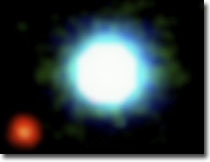|
||||||||||
|
|
||||||||||
|
April 30, 2005
In February and March of this year, the astronomers took new images of the young brown dwarf and its giant planet companion with the state-of-the-art NACO instrument on ESO's Very Large Telescope in northern Chile. The planet is near the southern constellation of Hydra and approximately 200 light years from Earth. "Our new images show convincingly that this really is a planet, the first planet that has ever been imaged outside of our solar system," tells Gael Chauvin, astronomer at ESO and leader of the team of astronomers who conducted the study. "The two objects - the giant planet and the young brown dwarf - are moving together; we have observed them for a year, and the new images essentially confirm our 2004 finding," says Benjamin Zuckerman, UCLA professor of physics and astronomy, member of NASA's Astrobiology Institute, and a member of the team. "I'm more than 99 percent confident." The separation between the planet and the brown dwarf is 55 times the separation of the Earth and Sun. The new discovery brings to 145 the total number of planets that have been discovered outside our solar system.
|
|||||||||||||||||||||||||||||||||||||||||
Privacy/Copyright |
Site Map |
Feedback |
Glossary |
Awards & Credits |
For Educators |
For Press |
Widgets |
|
|


